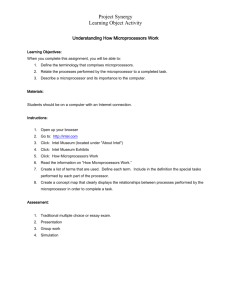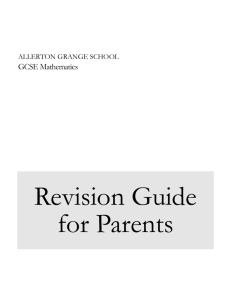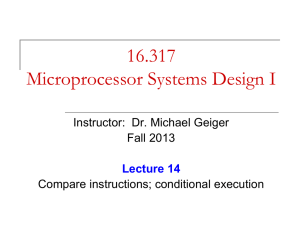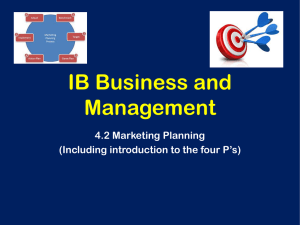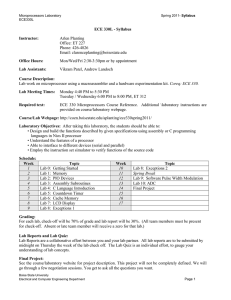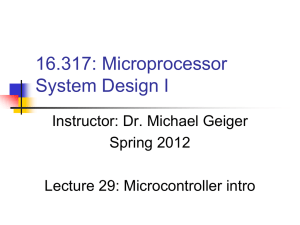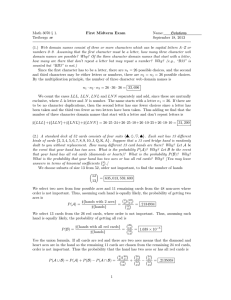Math 3070 § 1. First Midterm Exam Name: Solutions
advertisement
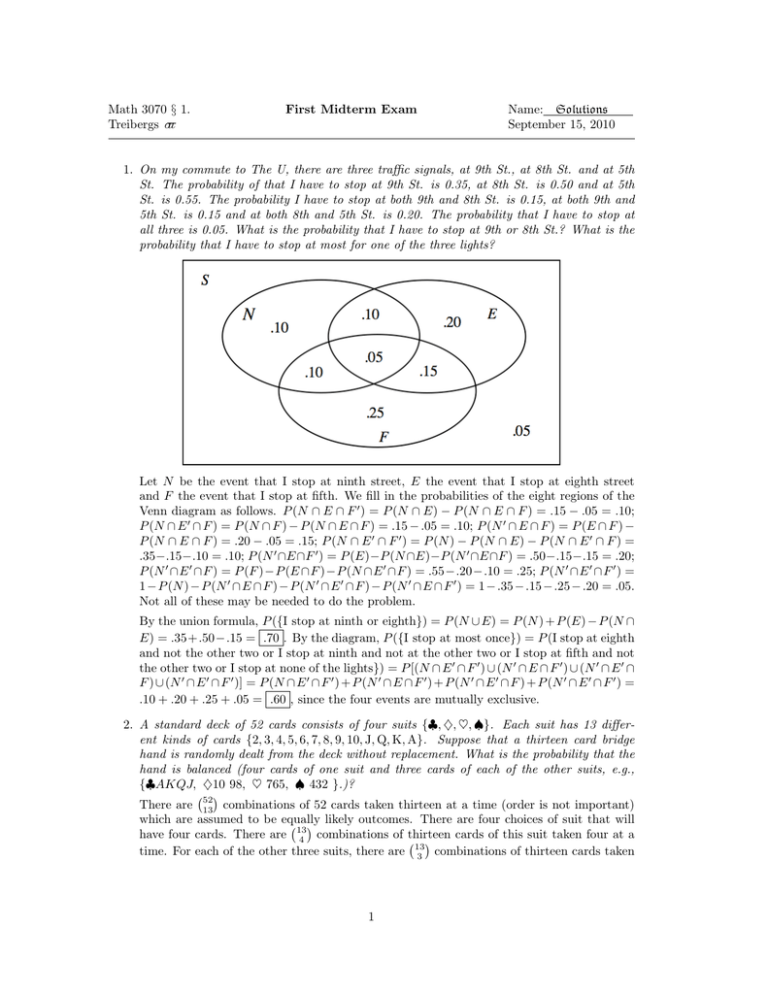
Math 3070 § 1.
Treibergs σ−
ιι
First Midterm Exam
Name: Solutions
September 15, 2010
1. On my commute to The U, there are three traffic signals, at 9th St., at 8th St. and at 5th
St. The probability of that I have to stop at 9th St. is 0.35, at 8th St. is 0.50 and at 5th
St. is 0.55. The probability I have to stop at both 9th and 8th St. is 0.15, at both 9th and
5th St. is 0.15 and at both 8th and 5th St. is 0.20. The probability that I have to stop at
all three is 0.05. What is the probability that I have to stop at 9th or 8th St.? What is the
probability that I have to stop at most for one of the three lights?
Let N be the event that I stop at ninth street, E the event that I stop at eighth street
and F the event that I stop at fifth. We fill in the probabilities of the eight regions of the
Venn diagram as follows. P (N ∩ E ∩ F 0 ) = P (N ∩ E) − P (N ∩ E ∩ F ) = .15 − .05 = .10;
P (N ∩ E 0 ∩ F ) = P (N ∩ F ) − P (N ∩ E ∩ F ) = .15 − .05 = .10; P (N 0 ∩ E ∩ F ) = P (E ∩ F ) −
P (N ∩ E ∩ F ) = .20 − .05 = .15; P (N ∩ E 0 ∩ F 0 ) = P (N ) − P (N ∩ E) − P (N ∩ E 0 ∩ F ) =
.35−.15−.10 = .10; P (N 0 ∩E∩F 0 ) = P (E)−P (N ∩E)−P (N 0 ∩E∩F ) = .50−.15−.15 = .20;
P (N 0 ∩E 0 ∩F ) = P (F )−P (E ∩F )−P (N ∩E 0 ∩F ) = .55−.20−.10 = .25; P (N 0 ∩E 0 ∩F 0 ) =
1 − P (N ) − P (N 0 ∩ E ∩ F ) − P (N 0 ∩ E 0 ∩ F ) − P (N 0 ∩ E ∩ F 0 ) = 1 − .35 − .15 − .25 − .20 = .05.
Not all of these may be needed to do the problem.
By the union formula, P ({I stop at ninth or eighth}) = P (N ∪ E) = P (N ) + P (E) − P (N ∩
E) = .35+.50−.15 = .70 . By the diagram, P ({I stop at most once}) = P (I stop at eighth
and not the other two or I stop at ninth and not at the other two or I stop at fifth and not
the other two or I stop at none of the lights}) = P [(N ∩ E 0 ∩ F 0 ) ∪ (N 0 ∩ E ∩ F 0 ) ∪ (N 0 ∩ E 0 ∩
F ) ∪ (N 0 ∩ E 0 ∩ F 0 )] = P (N ∩ E 0 ∩ F 0 ) + P (N 0 ∩ E ∩ F 0 ) + P (N 0 ∩ E 0 ∩ F ) + P (N 0 ∩ E 0 ∩ F 0 ) =
.10 + .20 + .25 + .05 = .60 , since the four events are mutually exclusive.
2. A standard deck of 52 cards consists of four suits {♣, ♦, ♥, ♠}. Each suit has 13 different kinds of cards {2, 3, 4, 5, 6, 7, 8, 9, 10, J, Q, K, A}. Suppose that a thirteen card bridge
hand is randomly dealt from the deck without replacement. What is the probability that the
hand is balanced (four cards of one suit and three cards of each of the other suits, e.g.,
{♣AKQJ, ♦10 98, ♥ 765, ♠ 432 }.)?
There are 52
13 combinations of 52 cards taken thirteen at a time (order is not important)
which are assumed to be equally
likely outcomes. There are four choices of suit that will
have four cards. There are 13
cards of this suit taken four at a
4 combinations of thirteen
time. For each of the other three suits, there are 13
combinations
of thirteen cards taken
3
1
three at a time. All together, there are 4×
13
4
×
13 3
3
balanced hands. Thus the probability
13 3
4 × 13
4 × 3
= .105
P ({balanced hand}) =
52
13
3. The Sandy Candy Company sends 50% of its overnight mail parcels by UteEx, 30% by
CityEx and 20% by StateEx. Suppose 1% of the packages sent by UteEx arrive late, 4% sent
by CityEx arrive late and 7% sent by StateEx arrive late. If a certain package arrived on
time, what is the probability that it was sent via UteEx?
Let U denote the event that UteEx is used, C the event that CityEx is used and A the event
that StateEx is used. These are mutually exclusive and exhaustive events. Let L denote the
event that a package arrives late. We are given P (U ) = .5, P (C) = .3 and P (A) = .2. We are
also given the prior conditional probabilities P (L|U ) = .01, P (L|C) = .04 and P (L|A) = .07.
Thus P (L0 |U ) = 1 − .01 = .99, P (L0 |C) = 1 − .04 = .96 and P (L0 |A) = 1 − .07 = .93. We
are asked to compute the posterior probability P (U |L0 ). Using Bayes formula,
P (U |L0 ) =
P (U ∩ L0 )
P (L0 )
P (U ∩ L0 )
P (U ∩
+ P (C ∩ L0 ) + P (A ∩ L0 )
P (U )P (L0 |U )
=
0
P (U )P (L |U ) + P (C)P (L0 |C) + P (A)P (L0 |A)
(.5)(.99)
=
(.5)(.99) + (.3)(.96) + (.2)(.93)
.495
.495
=
=
= .511 .
.495 + .288 + .186
.969
=
L0 )
Alternately, we could have used a tree diagram.
4. A bag contains 26 scrabble tiles, each labeled by a different letter of the alphabet. Three tiles
are randomly selected in order from the bag without replacement. How many different three
letter words can be selected from the bag? Let A be the event that the word from (a.) starts
with a vowel (A, E, I, O, U). Find the probability P (A). Let B be the event that the word
from (a.) ends with a vowel. Are the events A and B independent? Why?
Order of letters is important in words so we count permutations. There are P26,3 = 26 ·
25 · 24 = 15, 600 permutations of 26 letters taken three at a time. Since there are five
vowels, the number of words starting with a vowel is 5 · 25 · 24 = 3000 because there are
five possible starting vowels times the number of remaining tiles (25) for the second letter
times the number of remaining tiles (24) for the last letter. Thus, if each word is equally
likely, the probability
P (A) = P ({word starts with vowel}) =
5 · 25 · 24
5
=
= .192 .
26 · 25 · 24
26
Since we could have counted back to front just as well, the number of words that end with
a vowel is the same, so P (B) = P (A) = .192. The number of ways both first and last letters
are vowels is 5 · 4 · 24 = 480 because there are five choices for the vowel at the front, so
four choices remain for the vowel at the end and 24 remaining tiles to choose from for the
middle letter. Hence P (A ∩ B) = (5 · 4 · 24)/(26 · 25 · 24) = (5 · 4)/(26 · 25) = .0308. The
events A and B are not independent because
.0308 =
5·4
5·5
= P (A ∩ B) 6= P (B)P (A) =
= .0370.
26 · 25
26 · 26
2
5. Of the microprocessors manufactured by a certain process, 20% are defective. Four microprocessors are chosen at random. Assume that they function independently. Let Ai denote
the event that the ith microprocessor fails, where i ∈ {1, 2, 3, 4}.
(a) Express the compound event “all microprocessors work” in terms of the Ai ’s. What is
the probability that they all work? Be sure to explain where the independence assumption is used.
(b) Express the compound event “at least one microprocessors works” in terms of the Ai ’s.
What is the probability that at least one works?
(c) Express the compound event “exactly one microprocessors works” in terms of the Ai ’s.
What is the probability that exactly one works?
A0i is the event that the ith processor works and P (A0i ) = 1 − P (Ai ) = 1 − .2 = .8. The
event “all microprocessors work” is “the first works and the second works and the third
works and the fourth works” is A01 ∩ A02 ∩ A03 ∩ A04 . By independence, we may multiply
probabilities to find the probability of intersection. Thus
P ({all microprocessors work})
= P (A01 ∩ A02 ∩ A03 ∩ A04 )
= P (A01 )P (A02 )P (A03 )P (A04 ) = (.8)4 = .4096 .
The event “at least one microprocessors works” is the negation of the event “none of the
microprocessors work” which is (A1 ∩ A2 ∩ A3 ∩ A4 )0 . By independence, we may multiply
probabilities to find the probability of intersection. Thus
P ({at least one microprocessors works})
= P ({none of the microprocessors work}0 )
= 1 − P ({none of the microprocessors work})
= 1 − P (A1 ∩ A2 ∩ A3 ∩ A4 )
= 1 − P (A1 )P (A2 )P (A3 )P (A4 ) = 1 − (.2)4 = .9984 .
The event “exactly one microprocessors works” is the event “the first works and the others
don’t or the second works and the others don’t or the third works and the others don’t or
the fourth works and the others don’t” which is
(A01 ∩ A2 ∩ A3 ∩ A4 ) ∪ (A1 ∩ A02 ∩ A3 ∩ A4 ) ∪ (A1 ∩ A2 ∩ A03 ∩ A4 ) ∪ (A1 ∩ A2 ∩ A3 ∩ A04 ) .
By mutually exclusivity we may add probabilities to find the probability of union and then
use independence. Thus
P ({exactly one microprocessors works})
= P ((A01 ∩ A2 ∩ A3 ∩ A4 ) ∪ (A1 ∩ A02 ∩ A3 ∩ A4 )
∪(A1 ∩ A2 ∩ A03 ∩ A4 ) ∪ (A1 ∩ A2 ∩ A3 ∩ A04 ))
= P (A01 ∩ A2 ∩ A3 ∩ A4 ) + P (A1 ∩ A02 ∩ A3 ∩ A4 )
+ P (A1 ∩ A2 ∩ A03 ∩ A4 ) + P (A1 ∩ A2 ∩ A3 ∩ A04 )
= P (A01 )P (A2 )P (A3 )P (A4 ) + P (A1 )P (A02 )P (A3 )P (A4 )
+ P (A1 )P (A2 )P (A03 )P (A4 ) + P (A1 )P (A2 )P (A3 )P (A04 )
= 4(.8)(.2)3 = .0256 .
3
